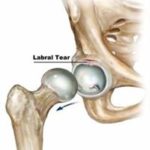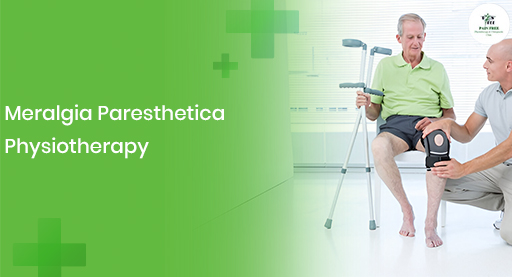Meralgia Paresthetica Physiotherapy
Ever feel like your thigh’s on fire for no good reason? Or maybe there’s this weird tingling sensation that just won’t quit, even though you didn’t pull a muscle or twist anything. If that rings a bell, chances are you’re brushing your shoulders with something called Meralgia Paresthetica.
Now, don’t let the name scare you; it sounds more like a spell from a wizarding movie than a nerve condition. But behind the tongue-twister name is a pretty common problem that can throw a wrench into your daily life. The good news? You don’t need a magic wand Meralgia Paresthetica Physiotherapy might just be your ticket to freedom.
What Is Meralgia Paresthetica, Anyway?
Before we talk about treatments, let’s untangle what’s actually going on.
Meralgia Paresthetica happens when the lateral femoral cutaneous nerve, a fancy term for the nerve that gives feeling to your outer thigh, gets squished or compressed. This nerve doesn’t affect muscle movement, but it sure knows how to holler when it’s irritated.
Most folks feel:
- Burning pain
- Tingling or numbness
- A buzzing sensation (kind of like your phone vibrating… in your leg)
- Heightened sensitivity to touch
And it typically hits one side of the body, usually the right or left outer thigh.
Why Is This Even Happening?
Well, your body isn’t trying to mess with you for fun. There’s always a trigger behind the scenes.
Common Causes of Meralgia Paresthetica
- Tight clothing: Think belts, skinny jeans, waist trainers, anything that squishes the pelvis.
- Weight gain or obesity: More weight – more pressure on nerves.
- Pregnancy: Growing bellies can press on the nerve pathway.
- Prolonged standing or walking: Especially if you’re on hard surfaces all day.
- Injury or trauma: A fall, a surgery near the hip, or even a seatbelt during a car accident can do it.
And sometimes? It just shows up uninvited. Frustrating, right?
Meralgia Paresthetica Physiotherapy: Your Non-Surgical Lifesaver
Alright, now let’s get to the good stuff. How do you get rid of it without going under the knife? Enter stage left: Meralgia Paresthetica Physiotherapy.
Physiotherapy is like a Swiss army knife of pain management. It helps reduce nerve compression, improve mobility, and stop that nerve from yelling at you all day long.
How Does Meralgia Paresthetica Physiotherapy Help?
- Releasing the Pressure Valve
The main goal? Take the pressure off that cranky nerve.
Physios may use:
- Soft tissue release techniques to ease tight muscles around the pelvis and hip.
- Myofascial release (yep, sounds fancy, but it’s basically hands-on magic).
- Dry needling to relax trigger points causing tension.
- Stretch It Out
If your muscles are tighter than a drum, it’s time to loosen them up.
Targeted stretches:
- Hip flexors
- Quads
- IT band
- Lower back
These aeas often gang up on the nerve if they’re stiff or inflamed.
- Strengthening the Support Squad
Weak core or glutes? They might be leaving your pelvis unstable, which messes with your nerve pathways.
You’ll work on:
- Core stabilization
- Glute activation
- Pelvic alignment exercises
- Posture Check (Yep, That Matters)
Turns out slouching isn’t just bad for your shoulders it can tweak the angle of your pelvis and irritate nerves.
Your physiotherapist will guide you on:
- Proper sitting and standing posture
- Ergonomic tweaks for your workspace
- Tips to avoid compressing the nerve in everyday life
Top Meralgia Paresthetica Physiotherapy Exercises
Here’s a short list of go-to moves physios often recommend:
- Pelvic tilts
- Glute bridges
- Cat-cow spinal mobilization
- Standing hip flexor stretch
- Foam rolling for the IT band
Heads up: Always check with a pro before starting these. You don’t wanna poke the bear.
Do’s and Don’ts While Recovering
Let’s not make things worse while trying to heal. Here’s what to keep in mind:
Do:
- Wear loose clothing
- Stay active but low-impact (think walking, swimming)
- Ice the area if it’s flaring up
- Follow your physio’s plan to a T
Don’t:
- Sit or stand for hours at a stretch
- Wear tight belts or jeans
- Ignore the pain and “walk it off”
- Skip stretches just ’cause you’re feeling better
FAQs: Meralgia Paresthetica Physiotherapy
Q: How long does it take for Meralgia Paresthetica to heal with physiotherapy?
A: It varies. Mild cases may ease up in a few weeks, while stubborn ones could take a few months. Consistency is key!
Q: Can I treat Meralgia Paresthetica at home?
A: You can manage symptoms like switching to looser clothes or doing light stretches—but full recovery usually needs a physiotherapist’s touch.
Q: Will it come back again?
A: It might especially happen if you go back to wearing tight clothes or don’t address the root cause. That’s why strengthening and prevention are part of physiotherapy.
Q: Is Meralgia Paresthetica a serious condition?
A: It’s not dangerous, but boy, can it be uncomfortable. Chronic cases can mess with your quality of life, so don’t brush it off.
Q: Should I see a doctor or a physiotherapist first?
A: If you’re not sure what’s going on, see a doc for a proper diagnosis. But once you know it’s Meralgia Paresthetica, a physiotherapist is your go-to for hands-on help.
Wrapping It Up: Don’t Let a Nerve Steal Your Groove
There’s no medal for pushing through burning pain, especially when help is within arm’s reach. Meralgia Paresthetica Physiotherapy offers a way to heal without pills, needles, or surgeries. It’s all about stretching what’s tight, strengthening what’s weak, and giving your poor nerve a break from being squished.
The sooner you jump on it, the faster you’ll be back to walking, sitting, and living without that electric shock vibe in your thigh. And hey, your jeans will still fit you’ll just wear them smart, not tight.
So if your leg’s been screaming and your nerves are clearly not in a good mood, don’t ignore it. Grab a physiotherapy appointment, ditch the compression, and show that nerve who’s boss.









